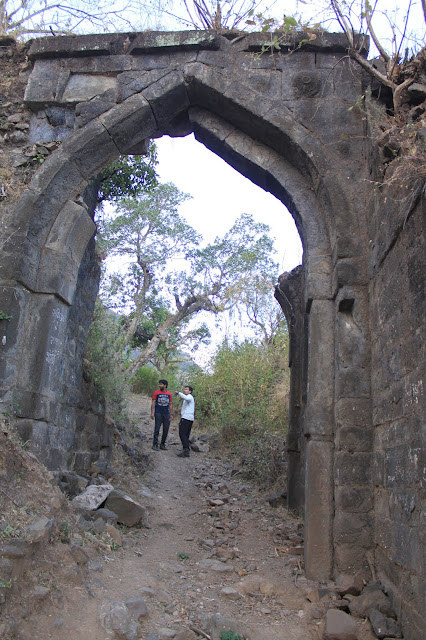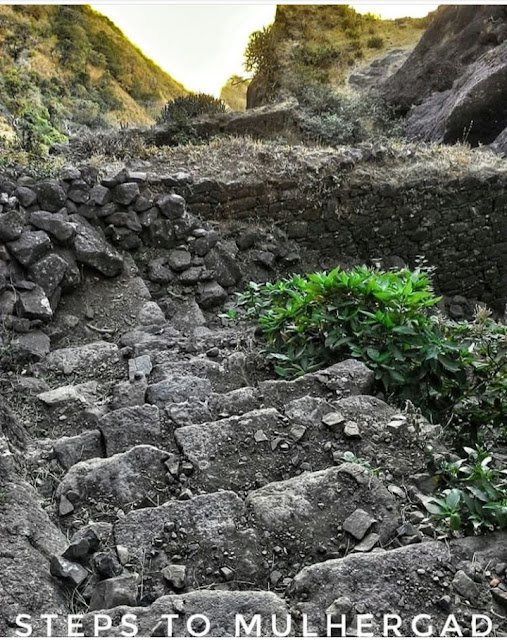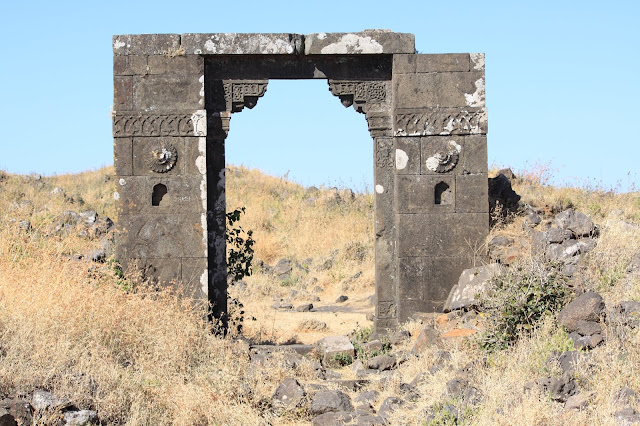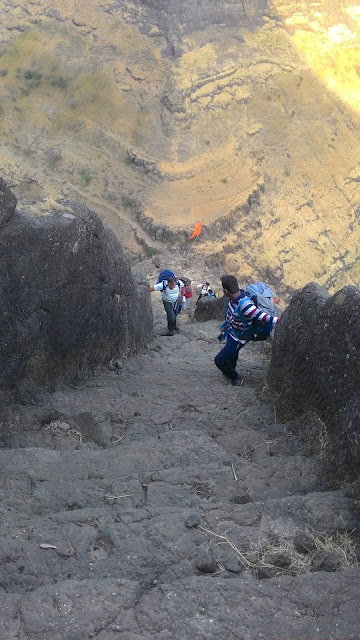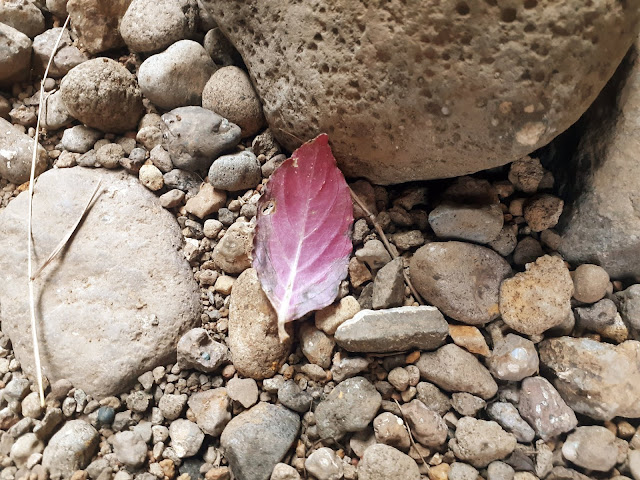 |
| A Scene from Sandhan Valley |
"I have a holiday on Saturday 24th November, lets plan an outing" I was delighted at this statement made my wife. After a long time, we both had some free-time over the weekend. I asked her if she would be interested to do a trek. She replied, if it involves lot of climbing, then I am not interested. I replied with the Sandhan Valley answer and voila, she was ready. It would be my fourth trip to Sandhan as I had done this prior with my trek buddies. She had heard and also seen some of my previous clicks of this trek and wanted to visit.
The Plan
We planned to travel to Sandhan on the weekend of 24th-25th November. It was a week just after the Diwali holidays and considering the travel route, we expected less crowd. I had a contact in Sandhan Valley which was made over my previous visits. The contact made arrangements for a two person tent near his house. We were to spend our entire day at Sandhan Valley and then travel to Nashik. The plan on 25th was to visit Sneha's friend roam around Nashik and then travel back to Pune. The total distance for these two days was close to six hundred kilometers with me being the only one to drive. We traveled in our dependable and ever ready for adventure vehicle Maruti Suzuki Ritz. Backpacks were packed, locked and loaded and vroom...we drove towards Nashik starting on Friday 23rd Novemeber around 8 pm.
The Night Drive and Tent Stay
We were to reach Sandhan late night. For dinner we halted near Hotel Purohit just after Rajgurunagar and then drove non-stop towards Sandan Valley. We drove via the Sangamner-Akole-Nimbral-Rajur-Bhandhardhara-Ratanwadi route, towards Sandhan. There is another route option which is via Ozar-Ottur-Bramhanwada-Kotul-Rajur, this saves around sixty kilometer. If you are going with a large group and are traveling via a bus, traveler etc. You can choose the second route, if you are traveling via private vehicle, then the NH60 is a better option till Sangamner. Post that one can take SH44 and SH21 route.
The drive was very lonely indeed, less traffic and less vehicles all the way. At certain sections on the SH44 you wont have any vehicle coming from opposite direction. Its a drivers road, the ones that love late night drive will love this route. We reached the Bandhardhara pass at 1 am in the night. Near this pass lies Lake Arthur or also known as the Bhandhardhara Dam Reservoir. A lot of small lakeside camps have sprung up in this area. There is a entry fee for using the Bhandhardhara reserve road, but we missed this as we traveled at night.
The drive was very lonely indeed, less traffic and less vehicles all the way. At certain sections on the SH44 you wont have any vehicle coming from opposite direction. Its a drivers road, the ones that love late night drive will love this route. We reached the Bandhardhara pass at 1 am in the night. Near this pass lies Lake Arthur or also known as the Bhandhardhara Dam Reservoir. A lot of small lakeside camps have sprung up in this area. There is a entry fee for using the Bhandhardhara reserve road, but we missed this as we traveled at night.
 |
| Break for me at Arthur Lake |
Earlier when I had traveled the Bhandhardhara-Ratanwadi road towards Sandhan, it was a very good road to drive, but this time round I was disappointed. The road was filled with crater size potholes. The drive from Bhandhardhara to Sadhan is not more than 35 kms, but the drive made it look like its 60 kms. I spent two hours driving in the potholes. The terrain is hilly and narrow and even though I was an experienced driver found it difficult and frustrating. Sneha was my co-driver like the rally drivers, but she was tired and slept. I had to drive alone with the radio music. You will not have any telephone range between Bhandhardhara and Sandhan as its a Sanctuary. So please download the map before hand to avoid route issues later. We reached the base village of Sandhan Valley which is Samrad at 2.30 am. The place we were put up was two kilometers ahead of Samrad.
 |
| The two person tent in which we were put up |
Seeing the size of the tent, Sneha was apprehensive whether we both, large souls would fit in it. We did fit into the tent perfectly with room to spare. Sneha was fast asleep, so before me calling it nights, clicked a few pics.
 |
| Me in the tent |
 |
| Funny me |
Morning at Sandhan
Woke up at 8 am a little early for a late night drive. Sneha was tired and wanted to take some more rest. In the meanwhile I started clicking pics of the beautiful surroundings. Since we were the only couple, our village contact Namdeo had accommodated us in his old home.
 |
| Neatly arranged kitchen |
 |
| For the door that matter - Imagine this being a toilet door :D |
 |
| The Surya Resha like the Laxman Resha |
The view behind the house was that of Alang-Madan-Kulang and Bhandardhara Dam.
 |
| Alang-Madan-Kulang in the background |
We asked Namdeo to help use with some breakfast of Pohe and Tea and after freshening up we made our way to the base village Samrad.
Sandhan all the way
On the way we could see the mighty Rantangad.
 |
| Ratangad at a distance |
Samrad was once a very sleepy not so disturbed village. Four years ago when I had made the trip for the first time, the villagers had a look at us as aliens from the towns, but now the place was buzzing with people. We parked our car and headed straight to the Sadhan Valley entrance.
 |
| Selfie before we begin the Sandhan Trek |
The route leading into Sandhan Valley is marked and you can easily find this.
 |
| Ratangad from Sandhan Trail |
As you walk ahead you come across a small jungle trail at the end of which is the Sandhan Valley.
 |
| At the Jungle Trail leading to Sandhan Valley |
Steadily we came near the opening of the valley which is small at first but then shares its surprise.
 |
| Stream of natural water, the real mineral water |
You come across a sudden drop to the narrow stream of water and witness the huge bolder lined-up one after the other.
 |
| Bolder as the way !!! |
The first part of Sandhan is easy as you make your way through a lot of bolders. They are unending. You need to have good shoes that can survive. Also one thing that we should be aware off is not to jump at such locations, because if you injure yourself, there is no easy way out and medical help is not near.
 |
| Bolders and their size. The way is between them |
The Water Passes
After the first drop, there are three water passes that you have to go through. The first two are easy and the water level thankfully is manageable, but the third water pass is deep and the water is chest high.
 |
| Sneha making her way through the first water pass - Water is deep in places but passable |
At the second water pass you need to take off your shoes, the water is knee deep. If you are fine with wet shoes, then just walk into the water. Always remember that wet shoes take time to grip on rocks and they are slippery, so thread carefully if your shoes get wet.
 |
| Sneha at the second water pass |
As you move ahead, the valley slowly opens up and narrows down, you keep dropping deeper from the place you started. The bolders get bigger and bigger.
 |
| The drop and the now narrower and tighter route |
You need to remember one thing when you are in Sandhan Valley, there is no place to take a bio break, so if you need to go, go in the before you begin the trek.
 |
| Me and Sneha at one of the many drop |
 |
| The narrower pass and also the place for the third water pass |
 |
| At the third water pass |
The third water pass is about fifty meters long with water reaching chest high.
 |
| Some other groups making their way |
One has to carry all his belonging in a backpack and carry it over ones head. Remember that you are going to get wet two times. Your clothes dry off by the time you make it to the end of the Valley.
 |
| Me making my way across the third water pass |
The long walk into the Valley of Shadows
After crossing the water pass, you come across a long walk-way. At this point you are in the absolute middle of two mountains which are now running parallel to each other.
 |
| The walkway and the two mountains running parallely |
 |
| The view of Valley of Shadows |
The walk is peaceful and the sunlight plays the game of hide and seek which is mesmerizing to witness. At one point of the walk, the valley is at its narrowest. The sun rays coming through it are a view to be seen. This walk-way and route is a paradise for photographers.
 |
| The game of shadows |
 |
| The narrowest place in Sandhan Valley |
 |
| View when you are going through the narrowest section |
There are unending bolders all the way.
 |
| The view of the Bolders |
We take very few selfies, but this was one location where we took a selfie :)
 |
| Selfie with Wife |
After a walk of about 30 mins, the valley opens up completely and there is drop of more than thousand feet at the end. One can walk down this valley. There are three rappelling points further which need expertise.
 |
| The open view of Sadhan Valley |
When you look beyond this point, you get to see bolders of the size of a small goods carrier vehicle :) We decided to take rest at this point and munched on our snacks. We had carried dry fruits, groundnut chikki (bar) and some fresh fruits.
 |
| Selfie time |
 |
| The view of the Valley one last time before we return |
During the monsoons, this place is unreachable. There are large water rapids and eventually form long waterfalls. After spending three hours within the valley we returned to the base village.
The water pass video
The end of our trek
After returning to the base village, we had a simple yet delicious lunch, freshened up and moved on to Nashik.
 |
| Our Delicious Lunch - Homemade |
We traveled via the Igatpuri-Goti road towards Nashik. We had plans to visit Sita Guha (Sita Caves), Pandav Leni (Pandav Caves) the next day and enjoy some local Nashik cuisine and return with souvenirs and we did that.
 |
| The Nashik Misal a local fast food cuisine |
It was a very satisfying trek of sorts. I wont be returning soon to this place now. The memories and the moments will remain with me forever. Travel whenever you have time and invest in journeys which will remain with you. Yes click pictures, but i would recommend you enjoy the moment of being there, because in the noise of our social media lives we have forgotten that :)
Hope you enjoyed the trek and the images. Please leave your comments and feedback. Ciao
Some points to remember:
1) Do not litter Sandhan Valley with your snacks packets and water bottles. Nature has not asked for them. Please take them back and dispose correctly.
2) Wear easy going clothes that can take the stress and strain of stretching.
3) Please carry enough water to drink and some fresh snacks as you do have anything available in between the valley walk.
4) Rappelling is a available in the base village, if one is interested.
5) Carry good water-proof backpacks, first-aid kit and extra waterproof gears, extra clothes, good sun caps and goggles etc.
6) Take selfies and photos carefully. Watch-out for minor rocks falling from the top of the valley, hence walk in the center.
7) Do not drink and avoid smoking at such locations.
8) Carry some old clothes, utensils and things that you do not use, the villagers may make some good use of it.
Contact in Sandhan
Name: Namdeo Bhande
Contact: +919689579281 (Preferable way to contact is phone call or SMS as there is communication range issue. Also let him know you got the contact from me)
Can help with: Accommodation for groups, couples etc, Rappelling activities, trek guide.






